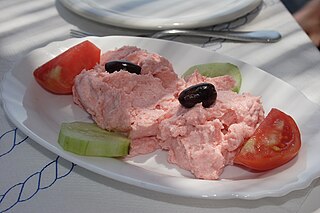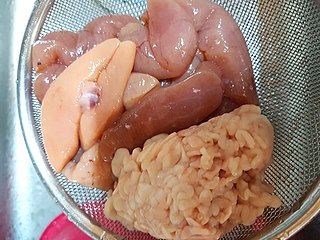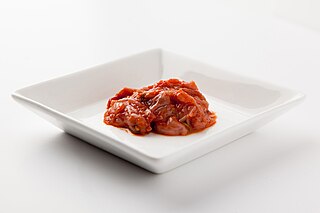
Roe, or hard roe, is the fully ripe internal egg masses in the ovaries, or the released external egg masses, of fish and certain marine animals such as shrimp, scallop, sea urchins and squid. As a seafood, roe is used both as a cooked ingredient in many dishes, and as a raw ingredient for delicacies such as caviar.

Chinmi (珍味) is a Japanese term meaning literally "rare taste", but more appropriately "delicacy". They are local cuisines that have fallen out of popularity or that are peculiar to a certain area. Many involve pickled seafood.

Taramasalata or taramosalata is a meze made from tarama, the salted and cured roe of the cod, carp, or grey mullet (bottarga) mixed with olive oil, lemon juice, and a starchy base of bread or potatoes, or sometimes almonds. Variants may include garlic, spring onions, or peppers, or vinegar instead of lemon juice. While not traditionally Greek, smoked rather than cured cod's roe is more widely available in some places, and often used. Bottarga is usually much more expensive than cod's roe.

Shiraoi is a town located in Iburi, Hokkaido, Japan. As of September 2016, the town had a population of 17,759. It was established in 1867 by the feudal lords of Sendai. Most of the area of the town is forested and parts lie within the Shikotsu-Tōya National Park.

Shiokara (塩辛)lit. 'salty-spicy', is a food in Japanese cuisine made from various marine animals that consists of small pieces of meat in a brown viscous paste of the animal's heavily salted, fermented viscera.

Gremolata or gremolada is a green sauce made of chopped parsley, lemon zest, and garlic. It is the standard accompaniment to the Milanese braised veal shank dish ossobuco alla milanese.

Bottarga is salted, cured fish roe pouch, typically of the grey mullet or the bluefin tuna. The best-known version is produced around the Mediterranean; similar foods are the Japanese karasumi and Taiwanese wuyutsu, which is softer, and Korean eoran, from mullet or freshwater drum. It has many names and is prepared in various ways. Due to its scarcity and involved preparation it is expensive and regarded as a delicacy.

Pollock roe, also pollack roe is the roe of Alaska pollock which, despite its name, is a species of cod. Salted pollock roe is a popular culinary ingredient in Korean, Japanese, and Russian cuisines.

The flathead grey mullet is an important food fish species in the mullet family Mugilidae. It is found in coastal temperate, tropical and subtropical waters worldwide. Its length is typically 30 to 75 centimetres. It is known with numerous English names, including the flathead mullet, striped mullet, black mullet, bully mullet, common mullet, grey mullet, sea mullet and mullet, among others.

Donggang Township or Tungkang Township is an urban township in west-central Pingtung County, Taiwan. Located on Taiwan's western coastline, along the Taiwan Strait, it has one of Taiwan's largest fishing harbors. Dapeng Bay with its national scenic area is just south of Donggang.

Cured fish is fish which has been cured by subjecting it to fermentation, pickling, smoking, or some combination of these before it is eaten. These food preservation processes can include adding salt, nitrates, nitrite or sugar, can involve smoking and flavoring the fish, and may include cooking it. The earliest form of curing fish was dehydration. Other methods, such as smoking fish or salt-curing also go back for thousands of years. The term "cure" is derived from the Latin curare, meaning to take care of. It was first recorded in reference to fish in 1743.

Bokkoms is whole, salted and dried mullet, and is a well-known delicacy from the West Coast region of South Africa. This salted fish is dried in the sun and wind and is eaten after peeling off the skin. In some cases it is also smoked. It is sometimes referred to as "fish biltong".

Jeotgal (Korean: 젓갈) or jeot (젓), translated as salted seafood, is a category of salted preserved dishes made with seafood such as shrimps, oysters, clams, fish, and roe. Depending on the ingredients, jeotgal can range from flabby, solid pieces to clear, broth-like liquid.

The Missolonghi-Aitoliko lagoons complex is located in the north part of the Gulf of Patras in the central west coast of Greece. It is one of the most important Mediterranean lagoons. It is a shallow area of 150 km2, extended between the Acheloos and Evinos rivers. It is protected by the Ramsar Convention and it is also included in the Natura 2000 network.

Cappon magro is an elaborate Genoese salad of seafood and vegetables over hardtack arranged into a decorative pyramid and dressed with a rich sauce.

The harvesting and consuming of seafoods are ancient practices that may date back to at least the Upper Paleolithic period which dates to between 50,000 and 10,000 years ago. Isotopic analysis of the skeletal remains of Tianyuan man, a 40,000-year-old modern human from eastern Asia, has shown that he regularly consumed freshwater fish. Archaeology features such as shell middens, discarded fish bones and cave paintings show that sea foods were important for survival and consumed in significant quantities. During this period, most people lived a hunter-gatherer lifestyle and were, of necessity, constantly on the move. However, where there are early examples of permanent settlements such as those at Lepenski Vir, they are almost always associated with fishing as a major source of food.
Eoran is fish roe such as mullet- or croaker-roe that is marinated in soy sauce while still in the ovary and then half-dried in the sun. It is considered a delicacy in Korean cuisine.
Irini Tzortzoglou is a Greek cook and winner of the MasterChef 2019 UK TV show competition.

The Étang de Palo is a coastal lagoon beside the Tyrrhenian Sea in the Haute-Corse department on the French island of Corsica. The lagoon is largely unspoiled and is considered ecologically valuable.




















